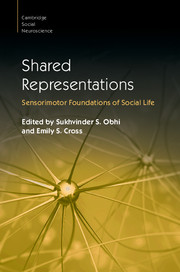Book contents
- Shared Representations
- Cambridge Social Neuroscience
- Shared Representations
- Copyright page
- Contents
- Figures
- Tables
- Boxes
- Contributors
- Preface
- Part I Foundations
- 1 What It Takes to Share a Task
- 2 Merged Minds
- 3 A New View of the Motor Cortex and Its Relation to Social Behavior
- 4 Beyond Action
- 5 Cognizance of the Neuroimaging Methods for Studying the Social Brain
- Part II Imitation and Mimicry
- Part III Thinking, Perceiving and Acting with Others
- Part IV Understanding Others
- Part V Learning and Development
- Part VI Shared Representations in Applied Contexts
- Index
- Plate Section (PDF Only)
- References
3 - A New View of the Motor Cortex and Its Relation to Social Behavior
from Part I - Foundations
Published online by Cambridge University Press: 27 October 2016
- Shared Representations
- Cambridge Social Neuroscience
- Shared Representations
- Copyright page
- Contents
- Figures
- Tables
- Boxes
- Contributors
- Preface
- Part I Foundations
- 1 What It Takes to Share a Task
- 2 Merged Minds
- 3 A New View of the Motor Cortex and Its Relation to Social Behavior
- 4 Beyond Action
- 5 Cognizance of the Neuroimaging Methods for Studying the Social Brain
- Part II Imitation and Mimicry
- Part III Thinking, Perceiving and Acting with Others
- Part IV Understanding Others
- Part V Learning and Development
- Part VI Shared Representations in Applied Contexts
- Index
- Plate Section (PDF Only)
- References
Summary
Three main views of the primate motor cortex have been proposed over the 140 years of its study. These views are not necessarily incompatible. In the homunculus view, the motor cortex functions as a rough map of the body’s musculature. In the population-code view, populations of broadly-tuned neurons combine to specify hand direction or some other parameter of movement. In the recently proposed action map view, common actions in the movement repertoire are emphasized in different regions of cortex. In the action map view, to fully understand the organization of the motor cortex, it is necessary to study the structure and complexity of the movement repertoire and understand how that statistical structure is mapped onto the cortical surface. This chapter discusses the action map in the primate brain and how some of the complex actions represented there may play a role in social behavior.
- Type
- Chapter
- Information
- Shared RepresentationsSensorimotor Foundations of Social Life, pp. 38 - 58Publisher: Cambridge University PressPrint publication year: 2016
References
- 3
- Cited by



